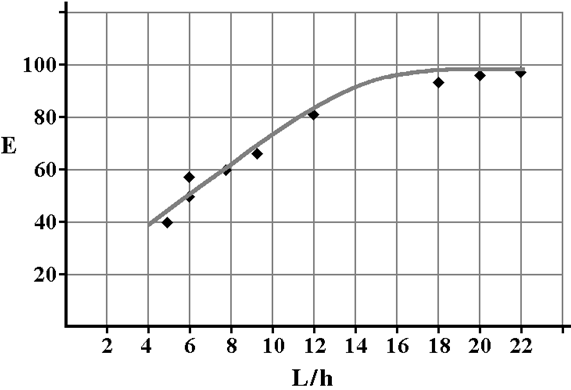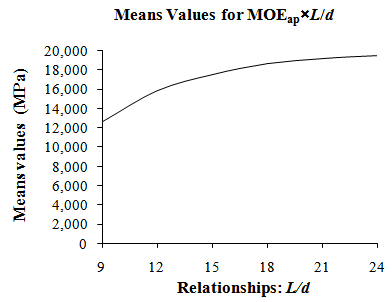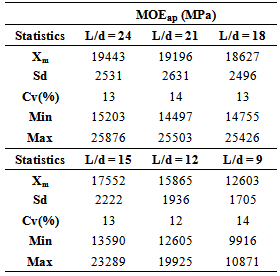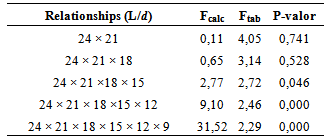-
Paper Information
- Next Paper
- Previous Paper
- Paper Submission
-
Journal Information
- About This Journal
- Editorial Board
- Current Issue
- Archive
- Author Guidelines
- Contact Us
International Journal of Materials Engineering
p-ISSN: 2166-5389 e-ISSN: 2166-5400
2014; 4(1): 37-40
doi:10.5923/j.ijme.20140401.05
Evaluation of the Shear Effect to Determine the Longitudinal Modulus of Elasticity in Corymbia Citriodora Round Timber Beams
André Luiz Zangiácomo1, André Luis Christoforo2, Decio Gonçalves3, Francisco Antonio Rocco Lahr3
1Department of Civil Engineering, Federal University of Lavras, Lavras, 37.200-000, Brazil
2Department of Civil Engineering, Federal University of São Carlos, 13565-905, Brazil
3Department of Structural Engineering, Engineering School of São Carlos (EESC/USP), São Carlos, 13566-590, Brazil
Correspondence to: André Luis Christoforo, Department of Civil Engineering, Federal University of São Carlos, 13565-905, Brazil.
| Email: |  |
Copyright © 2012 Scientific & Academic Publishing. All Rights Reserved.
This study aimed to investigate, based on three points static bending tests, the influence of ratio between length (L) and diameter (d) in structural round timber of Corymbia citriodora to determine the modulus of elasticity (MOE) using equations that do not consider shear influence in beam displacements. Non-destructive tests were carried out in 24 round pieces, medium length 750cm and average diameter 30 cm, moisture content around 12%. Modulus of elasticity for six different ratios (L/d) between length and diameter (9, 12, 15, 18, 21, 24) were determined, providing obtains six distinct values of MOE for each structural elements. Hypothesis tests results indicated equivalence of modulus of elasticity only to ratios (L/d) 24, 21 and 18. This implies that for proper use of the simplified equation to obtain MOE, based on static bending tests over structural round timber, it is necessary to respect L/h≥18 ratio.
Keywords: Round timber, Bending, Modulus of elasticity, Beams theory
Cite this paper: André Luiz Zangiácomo, André Luis Christoforo, Decio Gonçalves, Francisco Antonio Rocco Lahr, Evaluation of the Shear Effect to Determine the Longitudinal Modulus of Elasticity in Corymbia Citriodora Round Timber Beams, International Journal of Materials Engineering , Vol. 4 No. 1, 2014, pp. 37-40. doi: 10.5923/j.ijme.20140401.05.
1. Introduction
- Use of wood from reforestation areas, as structural elements, has been disseminated in Brazil[1]. Availability of this material associated with new technologies contributes to increase its use in structures, with emphasis on rural buildings. In this sector, lumber and round timber (in natural or profiled shapes) can be employed.Round pieces represent one of the most effective uses of forest resources, once require minimal processing between tree cutting and timber commercialization[2]. Pieces are peeled, dried and receive a preservative treatment before structural application. This product can be used in bridge, silos, containing structures, utility distribution lines, foundations, housing and so, as pointed out by Wolfe and Moody[3]; Wolfe and Kluge[4] and Zangiácomo[5].Brazilian Code ABNT NBR 7190[6] specifies round timber considering their top and base diameters, regardless of species. The same document states that properties of strength and stiffness are obtained from tests on clear specimens. But researchers as Zangiácomo[5] argue that it is appropriate to adopt tests in structural dimensions pieces, once they can better represent the material.Specimens proposed by ABNT NBR 7190[6] to obtain strength and stiffness wood properties in static bending present nominal dimensions 5cm×5cm×115cm. Tests must be carried out with 105cm nominal span, resulting ratio between length (L) and cross section width (h) equal to 21.Ratio L/h≥21 was obtained by Rocco Lahr[7], using three point static bending tests on clear wood specimens. Tests carried out on the same piece (nondestructive) differed only by successive supports approximation, allowing investigating the influence of relationships L/h on modulus of elasticity values, obtained from Equation 1, which take in account only normal stresses in bending (Euller-Bernoulli Theory). In the Equation 1, δ is the displacement at span in midpoint; F the applied force; L the span between supports; MOE is the modulus of elasticity and I the moment of inertia of the cross section.
 | (1) |
 | Figure 1. L/h relationships. Adapted from Rocco Lahr[7] |
2. Material and Methods
- Poles of Corymbia citriodora, chosen because derived from reforestation areas, were donated by company IRPA, São Carlos, Brazil (24 pieces). Poles, 25 years old, presented length of 750cm; medium diameter 30cm; density 0,90g/cm3; moisture content about 15%; and conicity 1cm/m.Tests to reach work’s aim were conducted in Wood and Timber Structures Laboratory (LaMEM), Structural Engineering Department (SET), São Carlos Engineering School (EESC), University of São Paulo (USP). Methodology to obtain MOE in different L/d ratios was based on Rocco Lahr[7], who employed three-point static bending tests, obtaining L/d 24, 21, 18, 15, 12 and 9, compounding six conditions for each pieces and one hundred forty four tests.To ensure physical and geometric linearity, non-destructive tests (NDT) were carried out and displacements at mid-span were restricted to L/200, as required by ABNT NBR 7190[6] to check the limit state for bi-supported beams.To verify the equivalence or not between the mean values of elastic moduli obtained from L/d relationship investigated were used hypothesis tests, with a significance level (α) of 5% (95% confidence), performed with the aid of Minitab software, version 14. If, for the degrees of freedom and significance level the parameter Fcalc (F calculated) obtained from the software is less than the tabulated parameter Ftab, supports the null hypothesis (H0: the population means are equal), or if the P-value is less than the significance level α, reject the null hypothesis[17].
3. Results and Discussions
- Table 1 presents: mean values (Xm); standard deviations (Sd); coefficients of variation (Cv); maximum (Max) and minimum (Min) of the apparent modulus of elasticity (MOEap) for each L/d investigated.
|
 | Figure 2. Diagram force×displacement of a structural round piece for the L/d ratios |
 | Figure 3. Mean values of apparent modulus of elasticity versus L/d relationships |
|
4. Conclusions
- Results found in this research showed valid to use Equation 1 only for relations L/d ≥18, close ratio to the obtained by Rocco Lahr[7] to lumber (L/h ≥21). This implies that, within the limit of the cited ratio L/d, three-point static bending test is able to determine modulus of elasticity once is truly negligible influence of displacements decurrently of shear stress, in these conditions.Finally, it must be registered that to determine displacements (δ) in bending bars, when L/d≤18, it’s indispensable apply equations that consider δ as function of the modulus of elasticity (MOE) and the shear modulus (G).
 Abstract
Abstract Reference
Reference Full-Text PDF
Full-Text PDF Full-text HTML
Full-text HTML
